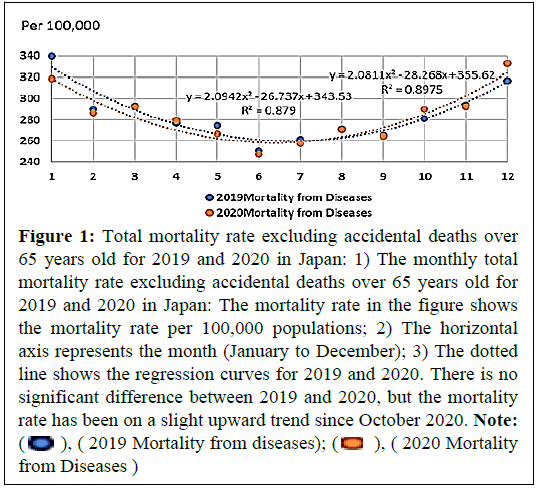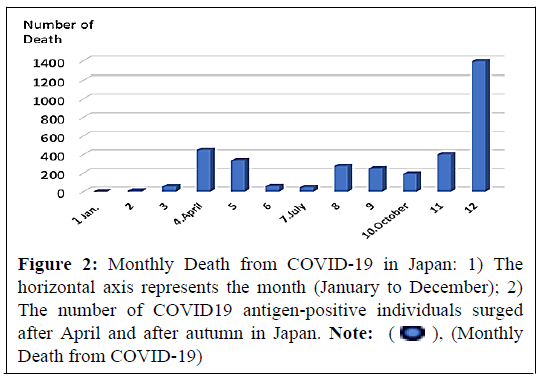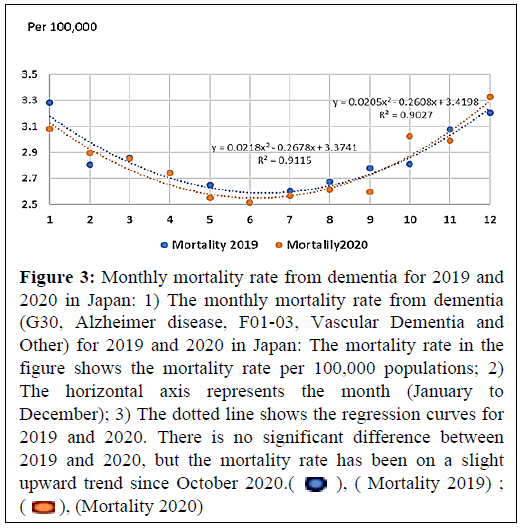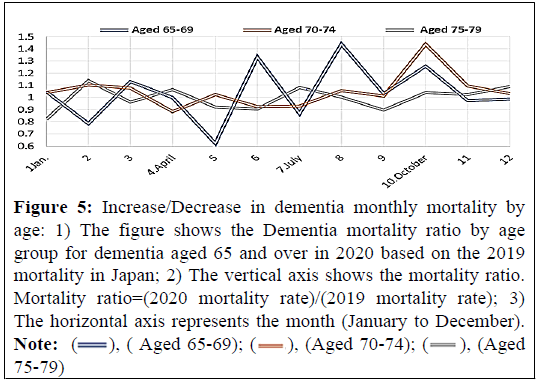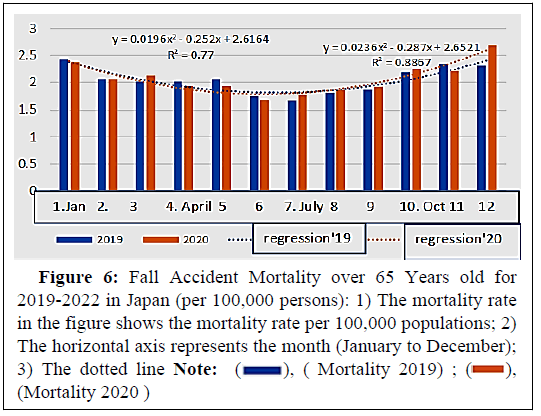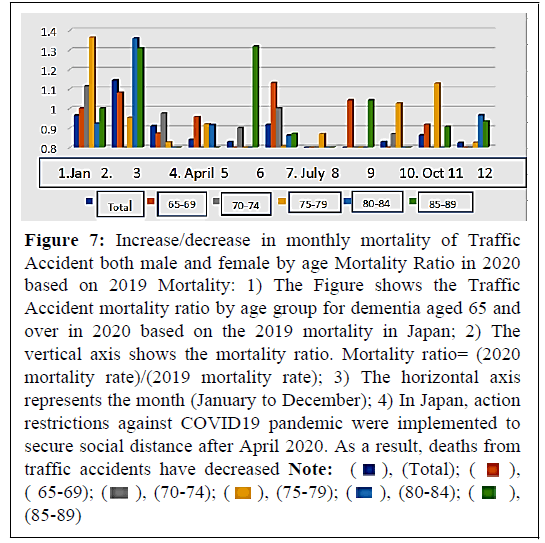Recent Trends in Dementia Mortality in Japan Based on Monthly Mortality Rate
Received: 26-Jul-2022 / Manuscript No. JADP-22-70313 / Editor assigned: 29-Jul-2022 / PreQC No. JADP-22-70313 (PQ) / Reviewed: 16-Aug-2022 / QC No. JADP-22-70313 / Revised: 23-Aug-2022 / Manuscript No. JADP-22-70313 (R) / Published Date: 30-Aug-2022 DOI: 10.4172/2161-0460.1000551
Abstract
The aim of this study is seasonal changes in dementia mortality in Japan and to pursue the excess death on COVID-19. From the monthly death from dementia (G30, Alzheimer disease, F01-03, Vascular Dementia and Other) extracted from the vital statistics in Japan from 2019 to 2020, the dementia mortality rate by sex-age group aged 65 and over was obtained. Dementia mortality did not differ significantly between 2019 and 2020, so excess mortality from COVID-19 infection could not be detected. However, the mortality rate has been on a slight upward trend since October 2020. Since autumn, an increase in mortality has been observed in the elderly aged 80 and over, compared to the mortality rate in the 65-79s. The existence of obvious excess deaths could not be proven. On the other hand, we suggested that there was an increase in dementia mortality among people aged 80 and over in Japan, which coincided with the time of the COVID-19 epidemic. Excess mortality from dementia could not be detected in 2020, but an increase in mortality was observed in the age group over 80 years old from the autumn.
Keywords: COVID-19; Dementia; Mortality; Monthly mortality rate; Vital statistics
About the Study
The aim of this study is to research seasonal changes in dementia mortality in Japan and to pursue the excess death on COVID-19. The excess mortality was higher in homes providing nursing services to older people with dementia in England by Morciano [1]. Morciano reported that excess deaths represented 6.5% of all care home beds, higher in nursing (8.4%) than residential (4.6%) homes. 64.7% of the excess deaths were confirmed/suspected COVID-19 in England. The most reported comorbidities from COVID-19 infection were arterial hypertension (40.8%), diabetes mellitus (22.0%), cardiovascular disease (17.2%), obesity (11.5%), Dementia was 2.9% [2].
We have been researched the temperature-mortality associations. The optimum temperature with the lowest mortality rate is the 84th percentile of the maximum temperature [3,4].
We compared the changes in monthly mortality between 2019 and 2020, and examined whether there is an indirect effect on dementia associated with COVID-19, considering the effects of temperature so far. For comparison, the total deaths of the elderly and accidental deaths such as falls were used.
From the monthly death from dementia (G30, Alzheimer disease, F01-03, Vascular Dementia and Other) extracted from the vital statistics in Japan from 2019 to 2020, the dementia mortality rate by sex-age group aged 65 and over was obtained. We estimated excess mortality using estimates from the optimal curves of monthly temperatures and monthly mortality rates for NCD since 2001, which the author has already announced. Seasonal changes in dementia in 2019-2020 were assessed to be consistent with estimates from optimal curves for monthly temperature and mortality.
The monthly total mortality rates for 2019 and 2020, excluding accidental deaths. In October-December 2020, the mortality rate increased slightly compared to the previous year (2019) as shown in Figure 1.
Figure 1: Total mortality rate excluding accidental deaths over
65 years old for 2019 and 2020 in Japan: 1) The monthly total
mortality rate excluding accidental deaths over 65 years old for
2019 and 2020 in Japan: The mortality rate in the figure shows
the mortality rate per 100,000 populations; 2) The horizontal
axis represents the month (January to December); 3) The dotted
line shows the regression curves for 2019 and 2020. There is no
significant difference between 2019 and 2020, but the mortality
rate has been on a slight upward trend since October 2020.


The number of death from COVID-19 infection in Japan. The number of people positive for COVID-19 infection increased from April 2020, and the number of deaths gradually increased after August, reaching a record high of more than 1,200 in December as shown in Figure 2.
The monthly mortality rate of dementia. The most fitted regression curves for 2019 and 2020 have been created. Dementia mortality did not differ significantly between 2019 and 2020, so excess mortality from COVID-19 infection could not be detected as shown in Figure 3.
Figure 3: Monthly mortality rate from dementia for 2019 and
2020 in Japan: 1) The monthly mortality rate from dementia
(G30, Alzheimer disease, F01-03, Vascular Dementia and
Other) for 2019 and 2020 in Japan: The mortality rate in the
figure shows the mortality rate per 100,000 populations; 2)
The horizontal axis represents the month (January to
December); 3) The dotted line shows the regression curves for
2019 and 2020. There is no significant difference between
2019 and 2020, but the mortality rate has been on a slight
upward trend since October 2020.

However, the mortality rate has been on a slight upward trend since October 2020. Age-specific results of dementia mortality are that the 2020 mortality by gender-age-class based on 2019 increased sharply in June, August and October for ages 65-69 and in October (10.2%-43.8%) for ages 70-74. Furthermore, since autumn, an increase in mortality has been observed in the elderly aged 80 and over, compared to the mortality rate in the 65-79s as shown in Figures 4 and 5.
Figure 4: Increase/Decrease in dementia monthly mortality by
age in 2020 based on the 2019: 1) The Figure shows the
Dementia mortality ratio by age group for dementia aged 65 and
over in 2020 based on the 2019 mortality in Japan; 2) The
vertical axis shows the mortality ratio. Mortality ratio=(2020
mortality rate)/(2019 mortality rate); 3) The horizontal axis
represents the month (January to December).

Figure 5: Increase/Decrease in dementia monthly mortality by
age: 1) The figure shows the Dementia mortality ratio by age
group for dementia aged 65 and over in 2020 based on the 2019
mortality in Japan; 2) The vertical axis shows the mortality ratio.
Mortality ratio=(2020 mortality rate)/(2019 mortality rate); 3)
The horizontal axis represents the month (January to December).

Fall mortality rates for the elderly tended to be similar to total mortality. On the other hand, the traffic accident mortality rate has decreased. From May to August, falls and traffic accidents decreased, the total mortality of the elderly excluding accidents decreased during the same period. After October 2020 the mortality of aged 70 and over increased by 8 percent in Figures 6 and 7 [5-13].
Figure 7: Increase/decrease in monthly mortality of Traffic
Accident both male and female by age Mortality Ratio in 2020
based on 2019 Mortality: 1) The Figure shows the Traffic
Accident mortality ratio by age group for dementia aged 65 and
over in 2020 based on the 2019 mortality in Japan; 2) The
vertical axis shows the mortality ratio. Mortality ratio= (2020
mortality rate)/(2019 mortality rate); 3) The horizontal axis
represents the month (January to December); 4) In Japan, action
restrictions against COVID19 pandemic were implemented to
secure social distance after April 2020. As a result, deaths from
traffic accidents have decreased.


Conclusion
We observed the effect of COVID-19 infection on dementia mortality in Japan. As results, the existence of obvious excess deaths could not be proven. On the other hand, we suggested that there was an increase in dementia mortality among people aged 80 and over in Japan, which coincided with the time of the COVID-19 epidemic. This is consistent with the MMWR report.
Based on some meta-analysis of available data, dementia seems to be associated with an enhanced risk of mortality from COVID-19 infection. Several reasons can be proposed to explain these results. First, most of the patients with dementia were old in age and have other comorbid medical conditions that could increase the severity and mortality of infections.
Since autumn 2020, the number of clusters in Japan geriatric care facilities has increased significantly, so prolonged inactivity of physical activity, which contributes to weakened immune function, may increase mortality from dementia.
There are restrictions on the statistical use of dementia mortality. Nichols E and GBD 2019 Collaborators comments that there are large inconsistencies in coding practices in vital registration systems over time and between countries complicate the estimation of global dementia mortality.
The establishment of an accurate and reliable system of dementia vital statistics, including the use of double cause codes, must be called for. Hence it is concluded that, Excess mortality from dementia could not be detected in 2020, but an increase in mortality was observed in the age group over 80 years old from the autumn.
Acknowledgement
Thank Prof. Y. Honda for his appropriate advice and this work was supported by JSPS KAKENHI Grant Number JP17K01829.
Conflict of Interest
There is no conflict of interest to declare.
References
- Morciano M, Stokes J, Kontopantelis E, Hall I, Turner A (2021) Excess mortality for care home residents during the first 23 weeks of the COVID-19 pandemic in England: a national cohort study. BMC Med 19:71,
- Peiris S, Mesa H, Aysola A, Manivel J,Toledo J et al., (2021) Pathological findings in organs and tissues of patients with COVID-19: A systematic review. PLoS ONE 16(4):e0250708.
- Kanamori M, Honda Y (2021) A study on the relationship between monthly temperature and cause of death in Kyoto and Sapporo, Japan from 1995 to 2017. ISEE Vertical e-Poster P0389.
- Honda Y (2014) Heat-related mortality, In Quantitative risk assessment of the effects of climate change on selected causes of death, 2030s and 2050s.
- Jonathan M. Wortham, J, Lee S, Thomsons J, Davidson A et al., (2020) Characteristics of Persons Who Died with COVID-19-United States, MMWR Weekly July 17, 2020. 69(28): 923-929.
- Manabe T, Fujikura Y, Mizukami K, Akatsu H, Kudo K (2019) Pneumonia-associated death in patients with dementia: a systematic review and meta-analysis. PLoS ONE 14(3):e0213825.
- Bianchetti A, Rozzini R, Guerini F, Boffelli S, Ranieri P, et al., (2020) Clinical presentation of COVID19 in dementia patients. J Nutr Health Aging 24(6):560-562.
- Covino M, Matteis GD, Santoro M, Sabia L, Simeoni B, Candelli M et al (2020) Clinical characteristics and prognostic factors in COVID-19 patients aged~80 years. Geriatr Gerontollnt 24(6):560-562.
- Hwang JM, Kim JH, Park JS, Chang MC, Park D (2020) Neurological diseases as mortality predictive factors for patients with COVID-19: a retrospective cohort study. NeurolSci.
- Wan Y, Wu J, Ni L, Luo Q, YuanFan CF et al., (2020) Prognosis analysis of patients with mental disorders with COVID-19: a single-center retrospective study. Aging 12(12):11238-11244.
- Yang X, Yu Y, Xu J, Shu H, Xia J, Liu H et al., (2020) Clinical course and outcomes of critically ill patients with SARS-CoV-2 pneumonia in Wuhan, China: a single-centered, retrospective, observational study. Lancet Respir Med 8(5):475-481.
- Adair T, Temple J, Anstey KJ, Lopez AD (2022) Is the Rise in Reported Dementia Mortality Real? Analysis of Multiple-Cause-of-Death Data for Australia and the United States. Am J Epidemiol 191(7): 1270–1279,
- Nichols E, GBD 2019 Collaborators (2021) Global mortality from dementia: Application of a new method and results from the Global Burden of Disease Study 2019. Alzheimer’s Dement. 7:e12200.
Citation: Kanamori M, Suzuki M, Kanamori T, Naito T (2022) Recent Trends in Dementia Mortality in Japan Based on Monthly Mortality Rate. J Alzheimers Dis Parkinsonism 12: 551. DOI: 10.4172/2161-0460.1000551
Copyright: © 2022 Kanamori M, et al. This is an open-access article distributed under the terms of the Creative Commons Attribution License, which permits unrestricted use, distribution, and reproduction in any medium, provided the original author and source are credited.
Select your language of interest to view the total content in your interested language
Share This Article
Recommended Journals
Open Access Journals
Article Tools
Article Usage
- Total views: 3096
- [From(publication date): 0-2022 - Dec 21, 2025]
- Breakdown by view type
- HTML page views: 2588
- PDF downloads: 508

